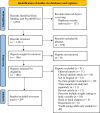A scoping review of the research literature on eating and body image for transgender and nonbinary adults
- PMID: 37400915
- PMCID: PMC10318796
- DOI: 10.1186/s40337-023-00828-6
A scoping review of the research literature on eating and body image for transgender and nonbinary adults
Abstract
Background: Eating disorder treatment approaches and outcome studies have historically centered almost exclusively on cisgender populations. Transgender and nonbinary (TGNB) adults are underrepresented in general and intervention research despite being at increased risk for eating and body image-related problems.
Aims: This scoping review was designed to gather and examine the research with TGNB adults who experience eating and body image related problems, as well as clinical studies on the effectiveness of treatment approaches.
Method: Preferred Reporting Items for Systematic Reviews and Meta-Analyses extension for Scoping Reviews (PRISMA-ScR) was used for reporting this review. MEDLINE and PsychInfo were used as electronic databases for searching subject terms. Inclusion criteria for studies required the quantitative measurement or qualitative exploration of body image or eating for TGNB adults. The relevant data were extracted and summarized based on quantitative findings and qualitative themes.
Results: After review of over 1258 articles, 59 studies met criteria and data were extracted and summarized. Factors associated with eating disorders and body image problems across studies suggests gender-affirming medical interventions are effective and emphasized treatment for an eating disorder is warranted alongside gender affirming medical care. Body image was associated with eating patterns aimed at meeting gendered ideals of body shape and size. There was variation in guiding theories and absence of consensus in the definition of transgender in the review studies. This likely demonstrates the changing language, social acceptance of TGNB people and identities, diagnostic criteria, and clinical conceptualizations of eating and body image.
Conclusions: Future research should consider the use of theory for guiding inclusion of salient social factors influencing eating patterns, body image, and treatment outcomes. In addition, future research is needed that centers on nonbinary and genderqueer populations, as well as those from minoritized racial and ethnic groups to inform culturally appropriate concerns, needs, and treatment modalities.
Keywords: Body image; Disordered eating; Eating; Transgender; Weight.
Plain language summary
Fifty-nine published research studies with transgender adults on eating patterns, body image, and associated risks and comorbidities were collected and summarized. Across studies, gender affirming medical interventions like hormone therapy and surgery were associated with decreases in eating disorder symptoms and improved body image. Studies from interviews with transgender adults found social causes for disordered eating and poor body image including rejection and discrimination. Future studies should use guiding theories for testing the causality and consider rejection and discrimination experienced by transgender adults.
© 2023. The Author(s).
Conflict of interest statement
The authors declare that they have no competing interests.
Figures
References
-
- Jones BA, Haycraft E, Murjan S, Arcelus J. Body dissatisfaction and disordered eating in trans people: a systematic review of the literature. 2016. - PubMed
Publication types
Grants and funding
LinkOut - more resources
Full Text Sources
Miscellaneous


